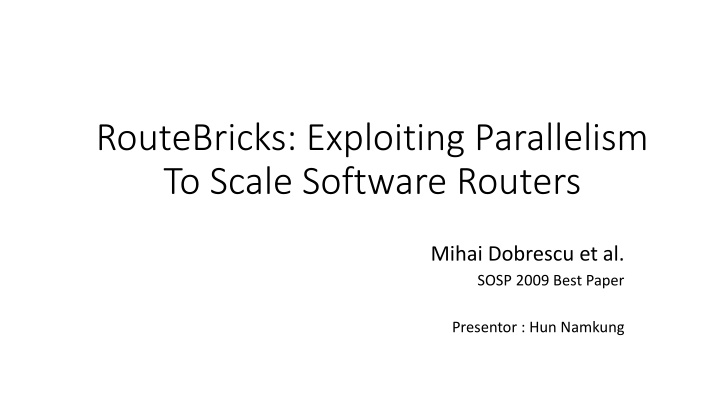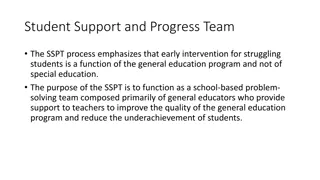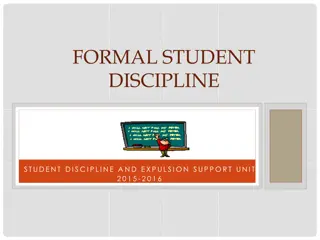
Exploiting Parallelism for Scaling Software Routers
Explore the innovative approach of RouteBricks in leveraging parallelism to enhance the scalability of software routers. The paper discusses parallelization across servers and within servers, aiming to achieve high performance and efficiency. Discover the key insights from the SOSP 2009 Best Paper on RouteBricks, presented by Hun Namkung.
Download Presentation

Please find below an Image/Link to download the presentation.
The content on the website is provided AS IS for your information and personal use only. It may not be sold, licensed, or shared on other websites without obtaining consent from the author. If you encounter any issues during the download, it is possible that the publisher has removed the file from their server.
You are allowed to download the files provided on this website for personal or commercial use, subject to the condition that they are used lawfully. All files are the property of their respective owners.
The content on the website is provided AS IS for your information and personal use only. It may not be sold, licensed, or shared on other websites without obtaining consent from the author.
E N D
Presentation Transcript
RouteBricks: Exploiting Parallelism To Scale Software Routers Mihai Dobrescu et al. SOSP 2009 Best Paper Presentor : Hun Namkung
Contents 1. Introduction 2. Parallelizing Across Servers HW Router 3. Parallelizing Within Servers 4. Evaluation 5. Conclusion Many of the contents are from SOSP 2009 Slides RouteBricks
Contents 1. Introduction 2. Parallelizing Across Servers HW Router 3. Parallelizing Within Servers 4. Evaluation 5. Conclusion Many of the contents are from SOSP 2009 Slides RouteBricks
1. Introduction 1.1 HW router vs SW router HW router Fast Throughput : Tbps No programmability SW router Throughput < 10Gbps General-purpose CPUs Programmable New network services / Research innovation / Management / etc
1. Introduction 1.2 RouteBricks Off-the-shelf PCs Uses Purely general purpose CPUs, purely software router Advantage Familiar programming environment Large-volume manufacturers, thus low cost Rapid advances in technology/features RouteBricks Can this approach achieve Tbps? Goal : achieve performance/scalability as much as possible
2. Parallelizing Across Servers 2.1 Requirements Internal link rates < R (low cost) Per-server processing rate : c x R (where c > 1, independent from N, scalability) Per-server fanout : constant (scalability)
2. Parallelizing Across Servers 2.2 A Na ve Solution ?2 internal links of capacity R, not cost efficient.
2. Parallelizing Across Servers 2.3 Better Solution VLB(Valiant Load Balancing) One more layer Link capacity R -> R/N L. Valiant et al. Universal Schemes for Parallel Communication. (STOC), 1981.
2. Parallelizing Across Servers 2.3 Better Solution VLB(Valiant Load Balancing) 2 x ?2internal links of R/N, more cost efficient Does not solve limited fanout problem
2. Parallelizing Across Servers 2.4 Extend VLB Off-the-shelf PCs-> limited number of PCIe slots (i.e 5 NICs) By combining both techniques, any number of ports(ie, N=32 or N=1024) can be supported Tradeoff : throughput will be degraded (each server need increased capacity) 1. Single server handle multiple ports 2. Add more layer as you need
3. Parallelizing Within Servers 3.1 NUMA architecture Sheer forwarding
3. Parallelizing Within Servers 3.2 Result
3. Parallelizing Within Servers 3.3 Batch Processing Result : 1.3Gbps -> 3Gbps
3. Parallelizing Within Servers 3.4 Multiple Queues
3. Parallelizing Within Servers 3.4 Multiple Queues 1 port, 2 cores Synchronization overhead 1 packet , 2 cores Cache misses
3. Parallelizing Within Servers 3.4 Multiple Queues Rule1. 1 core per packet Rule2. 1 core per queue Result : 3Gbps -> 9.7Gbps
4. Evaluation 4.1 Single-server performance Need to divide by three because there are 3 layers
4. Evaluation 4.2 With upcoming servers
5. Conclusion Scalable and fast software switch utilizing the state of the art HW(NUMA, multiple queue NIC cards) Programmable with click Performance is not close to HW router, but it shows SW router s future potential.






















